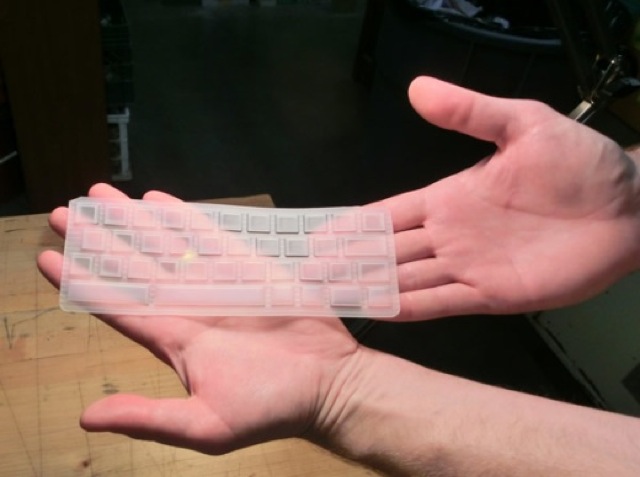
This week we’re running a three part series by Steven Isaac, a programmer with an amazing resume including stints at Sun, Microsoft, and even a hardware start-up that brought the first (non-portable) tablets. For years he’s dreamed of an easy-to-use device with a full keyboard that slides out when needed and, together with a designer, he built the Touchfire, a fully funded Kickstarter project that has only 10 days to go before production begins.
I asked him to create a series of short posts about his experience with the Kickstarter process and offer you, the hardware hackers out there, some advice and best practices.
My love affair with tablet computers began in 1988, when I became the seventh employee at a secretive startup called GO. I came from Sun Microsystems, where I led the team that made Sun’s Network File System (NFS) an industry standard. We succeeded beyond all expectations, and I had become restless. A new, scrappy startup like GO seemed like the perfect antidote.
GO was building one of the world’s first tablet computers, both the hardware and an entire operating system called PenPoint from scratch. My job was to write the mobility and connectivity software. Irresistible!
I was at GO for 5 years. During that time the hardware group spun off into a separate company called EO, which made a line of tablets that looked like iPads with ears. Not to mention a whip antenna and a full size telephone handset, complete with curly cord, that was used to access the clunky analog cellular networks of the era. The EO tablet was quite a sight to see, but we loved that machine and all the software we built on top of it.
I was at GO for 5 years. During that time the hardware group spun off into a separate company called EO, which made a line of tablets that looked like iPads with ears. Not to mention a whip antenna and a full size telephone handset, complete with curly cord, that was used to access the clunky analog cellular networks of the era. The EO tablet was quite a sight to see, but we loved that machine and all the software we built on top of it.
AT&T bought EO, then EO bought GO, and then AT&T shut the whole thing down. Tragic! But truthfully, PenPoint was all about the pen as the input device, and handwriting wasn’t the greatest way to get information into a computer. We had failed.
I went on to Microsoft, where I worked on a series of 1.0 products – Microsoft’s first mobile operating system Windows CE, Internet Explorer 1.0, the first MSN.com, and ASP.NET 1.0. I left Microsoft in 2000 to start my own consulting company. The years went by.
Then in the spring of 2010, Apple released the iPad. I felt as if I had stepped into a time machine. The iPad was everything we hoped for and dreamed of 20 years ago, done to perfection.
Well, almost perfect. Multi-touch typing was much better than every previous tablet input approach. But it still wasn’t great. Even Apple said that the iPad was primarily a consumption device. But I wanted to use my new iPad for everything – taking notes in real time, writing long emails, blogging, etc.
 So then I started thinking about how to make typing on an iPad great. And there was only one answer: add a tactile layer on top of the on-screen keyboard. Let people feel where the keys are; make typing comfortable (my fingers already hurt from banging away on the glass).
So then I started thinking about how to make typing on an iPad great. And there was only one answer: add a tactile layer on top of the on-screen keyboard. Let people feel where the keys are; make typing comfortable (my fingers already hurt from banging away on the glass).
 So then I started thinking about how to make typing on an iPad great. And there was only one answer: add a tactile layer on top of the on-screen keyboard. Let people feel where the keys are; make typing comfortable (my fingers already hurt from banging away on the glass).
So then I started thinking about how to make typing on an iPad great. And there was only one answer: add a tactile layer on top of the on-screen keyboard. Let people feel where the keys are; make typing comfortable (my fingers already hurt from banging away on the glass).
I realized that it was essential for the tactile layer to disappear when the user was finished typing. And it had to be stored within the tablet somehow, so it would always be available. How to do this?
I started prototyping ideas, settling on an approach that used stacks of thin elastic material. I didn’t know how the magic disappearing act would be done, but I thought that something lightweight and flexible stood the best chance.
 After a few months, I finally had a promising prototype. It was now time to find a mechanical engineer or industrial designer who could take my precious prototype to the next step. The search led to Brad, my future co-founder.
After a few months, I finally had a promising prototype. It was now time to find a mechanical engineer or industrial designer who could take my precious prototype to the next step. The search led to Brad, my future co-founder.
When he saw what I had made, he wasn’t impressed.
“The prototype is pretty bad”, Brad said. “But you are a software guy and the concept could really rock if done right. Let’s get going on this.”
Next: The Year Of The Prototypes

No comments:
Post a Comment